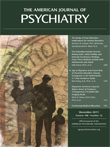Assessment of suicidal behavior and risk remains a source of apprehension for clinicians, clinical researchers, and the pharmaceutical industry. This apprehension has been exacerbated by U.S. Food and Drug Administration (FDA) “black box” warnings for antidepressants used with children and adolescents and by an increasingly litigious society. Much has been learned about risk factors and predicting suicide in the past decade, as succinctly summarized in a recent commentary by Brent (
1), who suggested that the field should be moving on to researching prevention, concomitant health risks such as substance abuse, and causal mechanisms. Even with this progress, however, dissemination of new precision measurements and training to improve suicide assessment lags behind (
2). Well-designed, precisely defined instruments for suicide assessment lessen apprehension about identifying potential suicidal behavior and increase precision in diagnosis as well as in treatment, prediction of risk, and monitoring of suicidal behavior, for clinicians, researchers, and the pharmaceutical industry (
3). In this issue, Posner et al. (
4) describe the psychometric properties of a new instrument, the Columbia–Suicide Severity Rating Scale (C-SSRS).
The drive toward improved assessment of suicide risk was an outgrowth of the development of newer antidepressant medications in the early 1990s and the emergence of questions about whether the new antidepressants increased suicide risk in youths. These questions led the FDA to establish a task force to develop and implement a suicidality classification system. The task force's retrospective review of existing studies with new assessment methods ultimately led to the FDA “black box” warnings that exist today. Research on the etiology and epidemiology of suicide before the FDA initiatives was flawed by lack of precision in definition and measurement. For example, one of the concerns was lack of agreement on how suicidal ideation and behavior were being described in the medical and research records and the inconsistent reporting of behaviors found in the records, if they were reported at all. A classic example, taking an overdose of a medication, was variously called a gesture, a threat, or an accident (if a low dose was taken) and dismissed based on incorrect notions about intent, seriousness, and lethality. On the other hand, superficial self-mutilation or suicidal thoughts with no intention to act on them were sometimes classified as attempts (
5). Early studies were just not designed to properly assess suicidality: a lack of consensus on terminology and of any systematic approach to measurement or reporting of the relevant behaviors resulted in a lot of misinformation. The task force convened by the FDA reviewed all of the child/adolescent antidepressant pharmaceutical trials that had been conducted up to that point and, in the process, exposed the inconsistencies and misleading reports in clinical records, raising serious questions about the reliability of any conclusions drawn from those data (
5). As a result, researchers developed greater precision in the operational definition and assessment of suicidal ideation and behavior, and soon the pharmaceutical industry will follow suit (
2).
Notably, instruments have since been designed and tested to enhance the objective assessment of suicidal behavior and to quantify the severity of ideation, the intensity of ideation, and the type of behavior involved (actual, aborted, or interrupted attempts; preparatory behavior; and nonsuicidal self-injurious behavior), as well as to monitor risk on a continuing basis. Nonsuicidal self-injurious behaviors were frequently characterized as “gestures” in the past, or simply dismissed. In fact, however, such behavior may well be important in predicting a future attempt, as has recently been reported (
6); the study authors also emphasized the importance of well-designed instruments and systematic clinical review to put such behavior in a proper context.
The psychometric and validity analysis of the C-SSRS that Posner et al. present in this issue was a direct outgrowth of their work with the FDA (
5). The psychometric validation they report is based on data from three fairly large multisite samples, including adolescents and adults for good external validity. Earlier versions of the instrument were used in the first study of treatment interventions for depressed adolescents who had attempted suicide (the Treatment of Adolescent Suicide Attempters [
7]). The greater precision offered by such instruments led to a greater number of correctly identified suicide-related behaviors—which in turn indicated a lower number of actual attempts.
The C-SSRS web site (
www.cssrs.columbia.edu) is a fine resource for clinical practitioners as well as researchers. High-risk patients are not uncommon in clinical practice, and thorough documentation is helpful for improving their treatment and mitigating risk for the treating clinician. The “since last visit” version of the scale assesses suicidality since the patient's last visit and documents monitoring of risk for a very-high-risk patient. The “risk assessment” version is a checklist for protective and risk factors for suicidality and assesses lifetime and past-week suicidality for crisis clinics or psychiatric emergency services. The instruments are available (in more than 100 languages) for pediatric and adult treatment, and online training and certification are offered.

